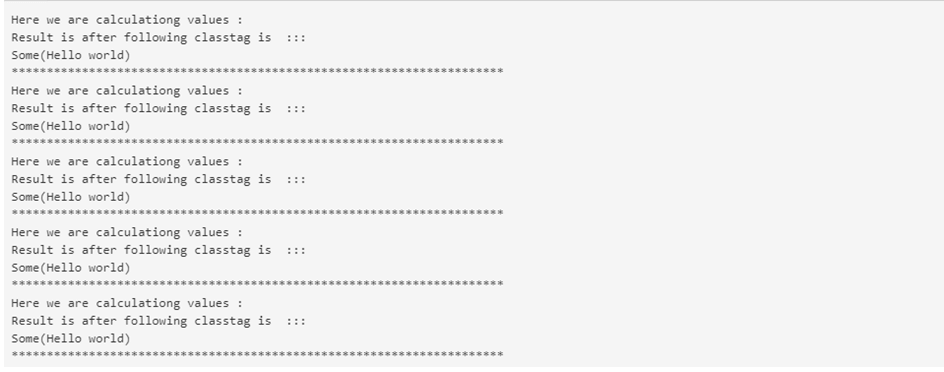Updated July 4, 2023
Definition of Scala Classtag
Scala classtag is useful when the variable types are not known at the compile time. ClassTag[T] are often used with Array or we can say they are beneficial to use with an array because we do not know the type of the variable at compile time. We have ‘Any’ type in Scala. In this, any type of element can come, which we cannot determine at the compile time; at runtime only we are able to know what type of element is coming, in such scenarios we can use ClassTag[T] in scala. In the coming section, we will discuss more this in detail for a better understanding of ‘ClassTag’.
Syntax:
As now we know is it the approach to determine and handle the element at the runtime so we have different approaches for that. Let’s have a look at its syntax as per the Scala doc see below;
def method_name[T]: return_type {
// method logic goes here.
}In the above lines of syntax, we have to give the name of the method followed by the return type. This method will return any type of element.
How does ClassTag Work in Scala?
As now we know that classtag is used to handle the element whose types are unknown at the runtime. If we do not handle this properly then we can get many exceptions while programming, for example, classCastException, etc. We have ‘Any’ type in Scala, that can hold any element type inside it. for example, it can be Integer, String. float, and many more. So let’s see one scenario where we have a map that can take up ‘Any’ as the value, but we have to handle it properly otherwise, the code will not work because, at the compile time, we do not know what kind of element it is holding, at runtime only we will get to know.
Let’s have a scenario where we need to handle our array data properly in order to avoid any exceptions while handling the data; see below;
Map[String, Any]: This map is holding key-value pair as String and Any. We can easily handle the key ‘String’ here because the element type is known at compile time only. But if we look at the ‘Any’ value of the map, then we cannot guess what it will hold. It can be anything, so we will see some approaches where we will see how to handle this situation using ClassTag[T] in Scala. See below;
We have three different approaches to this. We will discuss each of them in detail with all the scenarios and exceptions we can get while doing this let’s discuss each of them in detail see below;
- To check the instance of the element.
- To assign them to any specific type
- Use of classtag in scala
1. To Check the Instance of The Element
In this approach, we can check the instance of the coming element. Like we have ‘insatanceOf’ method in java. In Scala, we have ‘asInstanceOf[]’ in this method; we can check if the coming element is of a specific type or not. We just need to pass the type inside the [] square brackets. Let’s see its syntax and how we can use this in programming ;
var result = map("12").asInstanceOf[Int];In the above lines of code, we have our map in which the value comes out to be ’12’, which can be easily cast to int without any error or exception. This will run fine until the value is coming out to be an integer here. But the problem will occur when the value is string here. Let’s take one code snippet see below;
var result = map("Hello").asInstanceOf[Int];In the above lines of code, we are trying to cast a string then we will get classCastException here. So we are not able to handle this properly, and this line of code is erroneous. We can resolve this by using the classtag in Scala. This can only be determined at runtime only.
2. To Assign Them to Any Specific Type
In this approach, what we are trying to do is we are directly assigning the value to a variable without typecast, but we will going to get the error at compile time only. Let’s see one code snippet where we can understand it better. See below;
var result: Int = map("Hello");In the above line of code, we are assigning values to solve this problem. We can use an instance of the method here available in Scala, but this is also not the correct approach to solve this because we have already seen we might get some different values while typecasting it, so better to take a better approach to solve this. Here we can use ClassTag[T] available in Scala.
3. Use of ClassTag in Scala
In this approach, we can define a method that can take [T] type parameter and return any parameter. This approach will remove the error and exceptions from our code and make the program more scalable, readable, and under-stable by the developers. We can make some checks by checking into the map to see whether the key exists on the map or not. IF the key exists, then we can perform our operation, and if not present, we can return some there value or depend upon the requirement. Let’s see one sample method to handle this approach.
def getThevaleFromMap[T]():Option[t]{
// here we can write our logic to handle the values.
// we can also retrun vale we want of not present.
}Examples of Scala ClassTag
In this example, we are converting the map values by using ClassTag[T] approach, this is a simple program for beginners to understand it better.
Example
Code:
object Main extends App{
// Your code here!
val mymap1 : Map[String, Any]= Map("String1" -> "Hello world", "String2" -> "Hello other", "String2" -> "hello end bye", "String3" -> 200, "String4" -> 500, "String5" -> 900)
def getConvertedvalues[T](myKey: String, mymap: Map[String, Any]): Option[T] = {
println("Here we are calculationg values : ")
mymap.get(myKey) match {
case Some(i: T) => Some(i)
case _ =>; None
}
}
var result1: Option[String] = getConvertedvalues[String]("String1", mymap1)
println("Result is after following classtag is :::")
println(result1)
println("**********************************************************************")
var result2: Option[String] = getConvertedvalues[String]("String2", mymap1)
println("Result is after following classtag is :::")
println(result1)
println("**********************************************************************")
var result3: Option[Int] = getConvertedvalues[Int]("String3", mymap1)
println("Result is after following classtag is :::")
println(result1)
println("**********************************************************************")
var result4: Option[Int] = getConvertedvalues[Int]("String4", mymap1)
println("Result is after following classtag is :::")
println(result1)
println("**********************************************************************")
var result5: Option[Int] = getConvertedvalues[Int]("String5", mymap1)
println("Result is after following classtag is :::")
println(result1)
println("**********************************************************************")
}Output:
Conclusion
By using classtag we can handle the element of list and map or collection we can say at runtime when we are not aware of the element type at the compile time; this approach or the use of classtag can prevent to occur various errors or exceptions in the program like Incompatible type, classCastException and many more makes our program more scalable and reduce the number of lines of code that being return for other return types.
Recommended Articles
We hope that this EDUCBA information on “Scala Classtag” was beneficial to you. You can view EDUCBA’s recommended articles for more information.



